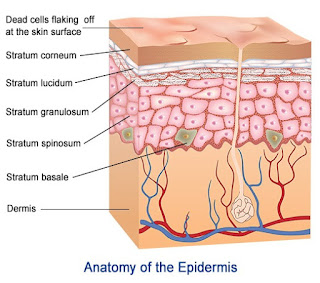- the skin is the largest organ of the body.
- it is made up of many special cells (epithelial) and forms a close fitting, protective covering for the skeletal system and vital organs.
- it contains many special structures including: follicles, hair, nails, sweat glands and sebaceous glands.
- the skin is very elastic and at the surface it is a dead substance, which is constantly being shed and replace by new growth.
- skin is composed of a protein known as keratin. skin is known as soft keratin and grows in flat sheet.
- hair is also composed of keratin; hair is known as hard keratin and grows in fibres.
There are 2 main layers and a secondary layer of the skin.
they are:
- Epidermis
- Dermis
secondary layer:
- Subcutaneous Tissue
EPIDERMIS
The epidermis is the outer layer of the skin. the one we see. it consists of the five sub-layers of stratum.
The 5 layers of the EPIDERMIS are:
- Stratum CORNEUM
- Stratum LUCIDUM
- Stratum GTANULOSUM
- Stratum MUCOSUM
- Stratum GERMINATIVUM
Stratum Corneum
- Top Layer
- cells contain no nuclei
- tightly packed flattened cells
- fully keratinised
- continually being shed and replaced
Stratum Lucidum
- Layer abovegranulosum
- Has traces of small flattened nuclei in some cells
- Has transparent keratinised cells only found in palms of the hand and soles of the feet
Stratum Granulosum
- Layer above mucous
- 2-3 layers of cells
- Nuclei degenerating more
- Cells loosing moisture
- Contains small granules, toughening cels
- Lips and skin under nails do not have granulosum
Stratum Mucosum
- Layer above the germinativum
- Several layers if the differently shaped cells
- Slight degeneration of nuclei has tissue fluid stored in this layer
Stratum Germinativum
- The base layer of the skin
- A single layer of nucleated cells - contain nuclei
- reproduction is occurring - new cells being formed
- Contain melanocytes - producing melanin
- in contact with with the dermis
DERMIS
Dermis is the thick layer of living tissue below the epidermis which forms the true skin, containing blood capillaries, nerve endings, sweat glands, hair follicles, and other structures.
The Dermis has 2 layers:
- PAPILLARY layer (Dermal Papillae)
- RETICULAR layer (Reticular Dermis)
Papillary Layer
- contains capillaries and never endings
- where the papillary layer joins the stratum germinativum is where the melanocytes are found
- made up of loose connective tissue - collagen and elastin
Reticular Layer
- Under the papillary layer
- help give skin its elasticity
- blood vessel and lymph vessels and (CIRCLATORY SYSTEM), nerves and sweat glands found here
- made up of dense connective tissue containing a network of collagenous and course elastic fibres
Connective tissue in the skin gives cushioning and support and maintains the bodies form.
SUBCUTANEOUS LAYER (TISSUE)
- A layer of fatty tissue between the dermis and the muscles and bones
- protects muscle, bones, and vital organs from injuries
- helps regulate body temperature
- stores energy
Secretion
sebum (oil) is secreted from the sebaceous gland to preserve the skins softness and suppleness
protects the body from infection
Excretion
Waste product are excreted in sweat from the sweat glands which is made up of water and trace elements
Eccrine glands distributed over the body. The highest density of eccrine glands is seen on the palms, soles and arm pits
Apocrine glands are larger and attached to the hair follicle. They are concentrated in the armpits and groin area.
Protection
skin protect your body in 4 ways:
- If your shoes rub your heels the skin will thicken in that area and form corns to calluses to protect that area of your body. Nerve endings send message to the brain to warn you of problems before they become dangerous to your skins health
- When when your skin is damaged by chemicals such as perm wave solution or soap sebum helps to prevent it from drying out(from chemical attack)
- The acid mental is the liquid coating on the surface of the skin with a natural acidity (pH 4.5 - 5.5) it not already maintains and enhances the condition of skin what it protects the skin from bacterial attack(from bacterial attack)
- The natural pigment in skin(Melanin) help to protect the skin from sunburn (from ultra-violet). The more the skin is exposed to ultra-violet rays, the more melanin is produced to filter there rays from the new cell production and the body's vital organ.




No comments:
Post a Comment